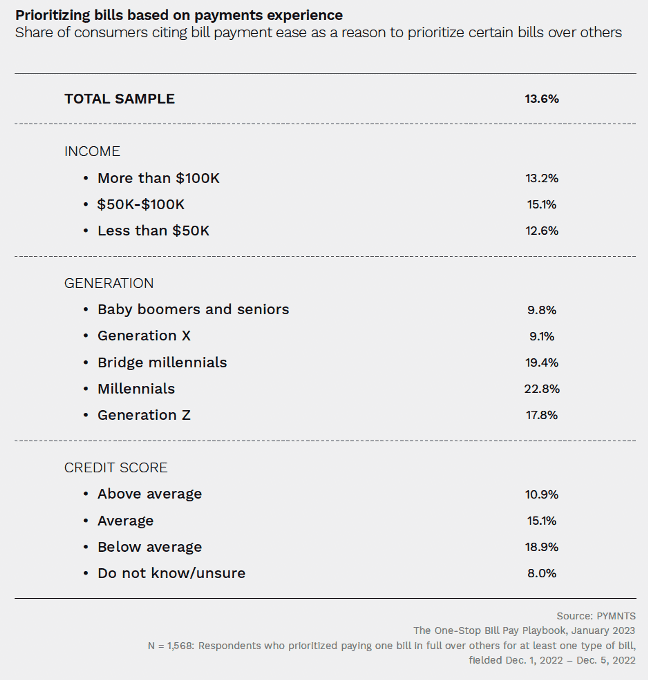Millennials More Likely to Skip Bills That Make It Too Hard to Pay
As budgets remain tight after last year’s extended period of heavy inflation, 27% of consumers have had to completely skip a bill, according to PYMNTS’ data.
For billing companies, making these payments convenient for customers can make a real difference in whether their bills are paid off or put off.
Unsurprisingly, essential bills take the top slot when it comes to pay priority. However, the “One-Stop Bill Pay Playbook,” a PYMNTS and Mastercard collaboration, found that 14% of consumers overall prioritize convenience in their bill paying, with the valuable millennial demographic most likely to feel this way. Seamlessness, especially when it comes to more discretionary bills, can motivate customers to pay those bills first, before addressing (or ignoring) those that involved friction-filled processes.

PYMNTS’ research has found that inconvenience far and away tops customers’ gripe list about the billing process, as 91% of billers reported that their customers complain about billing services. Inconvenience in the bill pay process can encompass factors such as log-in frustration, a lack of autopay options and authentication issues. Not enough choice in payment methods was also a common gripe (34% of billers reported receiving this complaint), and even that could be considered a subset of general bill pay convenience.
Larger firms tend to be more ready to tackle these problems than their smaller competitors. An average of 41% of smaller firms (those with less than $10 million in annual revenue) said a lack of payment choice was their top recurring complaint from bill-payers, whereas 25% of companies with revenue over $500 million said the same. Broadening payment options is an area that businesses may want to examine as part of their customer satisfaction strategy, as this feature has become a consumer demand instead of a “nice to have.”
One solution to bill pay friction that consumers in the United States are particularly open to is using a “one-stop” digital platform or portal to manage and pay their bills. Fifty-seven percent of all consumers surveyed said they were at least somewhat interested in switching to this sort of solution, and 32% reported that they were very or extremely interested. The top two features bill-payers expressed the most interest in from a one-stop solution were simplified tracking and convenience; 54% and 52% expressed interest in these, respectively. Thirty-one percent cited easier and more convenient payment experiences as the most important driver of their interest in using a one-stop solution.
Consumer frustration at inconvenience and friction carries a risk to businesses, as unhappy bill-payers are likely to switch services with the options they want when available. Forty-three percent of surveyed consumers experiencing one or two pain points when paying their bills would be very or extremely willing to switch providers offering a one-stop bill pay solution. This rate grows to 63% among consumers experiencing at least five pain points. Examples of pain points include security features or lack of payment options.
In the U.S., 55% of millennials would be very or extremely willing to switch providers for a one-stop bill pay solution, as would 37% of high-income consumers. Failure to provide some kind of all-in-one solution may put billing businesses at risk of losing their youngest as well as highest earning customers.
For businesses, reducing payment friction is one area they can manage to keep customers paying their bills regularly. And, for firms whose payments consumers find discretionary, offering such conveniences as one-stop bill pay may well be the innovation that keeps customers from going elsewhere.